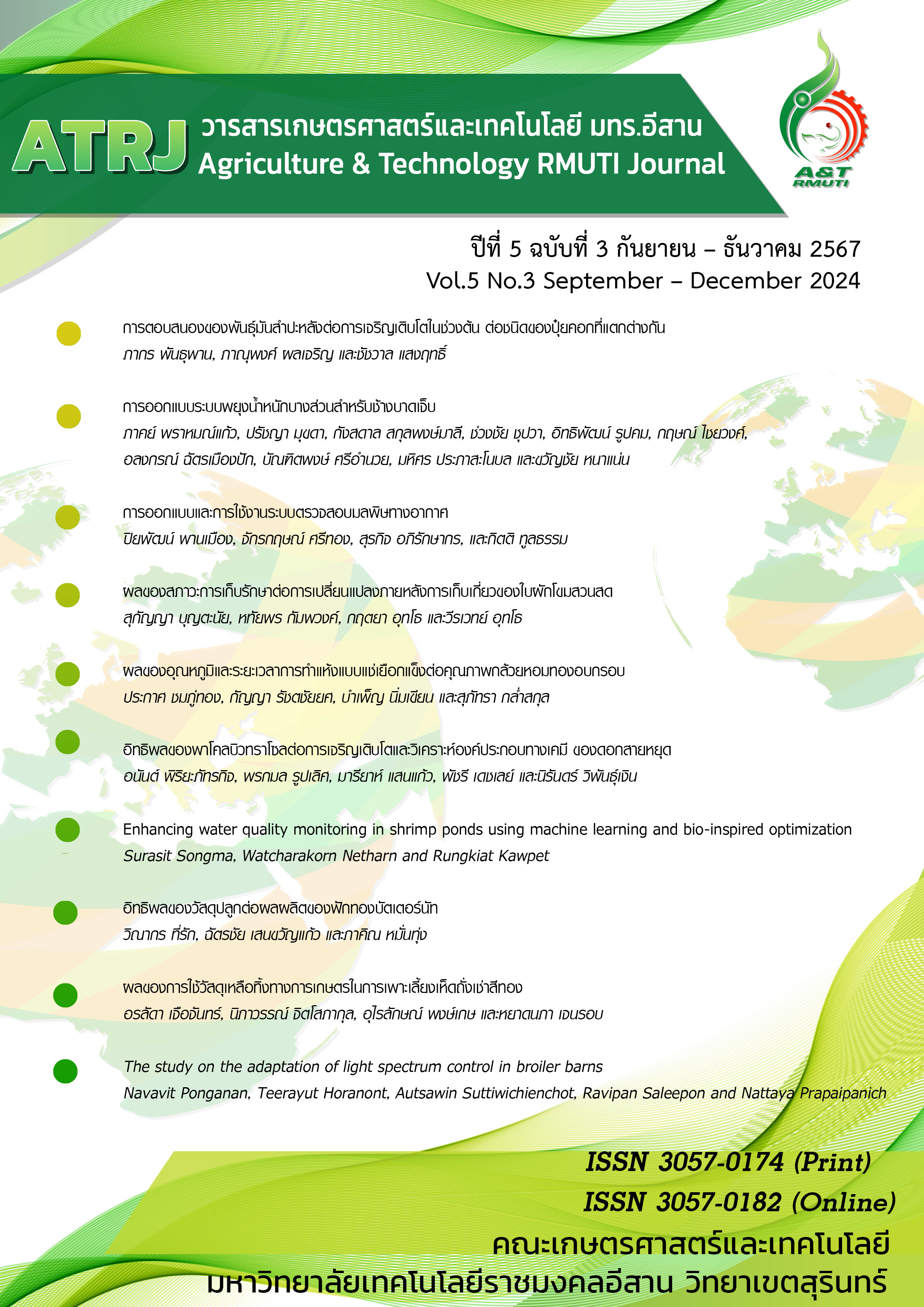Effect of storage conditions on postharvest changes of fresh amaranth leaves
Keywords:
Respiration rate, Fresh weight, Ascorbic acid content, Fresh amaranth leafAbstract
Fresh amaranth leaves have rapid changes in postharvest qualities causing decreases in marketability. This research undertaken purposely was to study effects of storage conditions including temperature (10-35°C) and time (10 days) on postharvest respiration rates, fresh weight, and ascorbic acid contents of fresh amaranth leaves. Experimental results show that such postharvest changes occurred at 10°C were slower than those at 25°C and 35°C. Increases in respiration rates were in exponential relations to storage temperatures, and these were well predicted using the Arrhenius model having R2 and RMSE (root mean square of errors) values of 0.98 and 0.08 respectively. The energy of activation was 32.65 kJ mol-1. The amaranth leaves losses their fresh weights continuously especially at 25°C and 35°C at which the fresh weight loss percentages were higher than 2.50 after 3-day storage. The leaves apparently became heavily wilt and lost their marketability. In contrast at 10°C, the amaranth leaves had the fresh weight loss percentages lower than 3.50 and had fresh appearances throughout the storage period. Ascorbic acid contents continuously decreases from their initial values (11.48 mg 100g-1) and became rapid reductions at 25°C and 35°C. The ascorbic acid contents at any time period were well predicted by the first order fractional conversion (FOFC model) of which the R2 and RMSE were 0.99 and 0.001-0.120, respectively. Increases of the FOFC model coefficients had exponential relationships with the storage temperatures, and these were well predicted by the Arrhenius model, having R2 and RMSE values of 0.99 and 0.02, respectively. The energy of activation was 93.10 kJ mol-1. Information of this present research is a guideline for making plans to delay quality changes of the fresh amaranth leaves during storage.
References
จริงแท้ ศิริพานิช. (2550). ชีววิทยาหลังการเก็บเกี่ยวและการวายของพืช. พิมพ์ครั้งที่ 2. โรงพิมพ์ศูนย์ส่งเสริมและฝึกอบรมการเกษตรแห่งชาติ: นครปฐม.
นิธิยา รัตนาปนนท์. (2545). เคมีอาหาร. พิมพ์ครั้งที่ 2. โรงพิมพ์โอเอสพริ้นติ้งเฮ้าส์: กรุงเทพฯ.
ปนิวัตน์ ทาสา และวีรเวทย์ อุทโธ. (2559). จลนพลศาสตร์ของการเปลี่ยนแปลงของคลอโรฟิลล์เอในใบผักชีฝรั่งที่สัมพันธ์กับอุณหภูมิการเก็บรักษาและสภาวะบรรยากาศดัดแปรในบรรจุภัณฑ์. ใน การประชุมวิชาการระดับชาติ มอบ.วิจัย ครั้งที่ 10 การพัฒนาท้องถิ่นสู่ภูมิภาคอาเซียน: งานวิจัยกับอนาคตสังคมไทย 7-8 กรกฎาคม 2559. มหาวิทยาลัยอุบลราชธานี. อุบลราชธานี.
พรชัย หาระโคตร, ลลิตา เจริญทรัพย์, ภาณุมาศ ฤทธิไชย และสมพงษ์ ทะบันหาร. (2563). ผลของอุณหภูมิและระยะเวลาการเก็บรักษาต่อคุณภาพปริมาณสารต้านอนุมูลอิสระและความสามารถในการยับยั้งอนุมูลอิสระในไมโครกรีนผักขี้หูด (Raphanus sativus var. caudatus Alef). วารสารแก่นเกษตร. 48(1): 201-210.
วีรเวทย์ อุทโธ. (2562). การบรรจุภัณฑ์บรรยากาศดัดแปรแอคทีฟสำหรับผักและผลไม้สด. พิมพ์ครั้งที่ 2. โรงพิมพ์มหาวิทยาลัยอุบลราชธานี: อุบลราชธานี.
วีรเวทย์ อุทโธ, วรงค์ นัยวินิจ, เรวัติ ชัยราช, วัชรพงษ์ วัฒนกูล และอดุลย์ อภินันทร์. (2563). การหายใจและการสูญเสียน้ำหนักของมะม่วงแก้วขมิ้นที่สัมพันธ์กับอุณหภูมิในระหว่างกิจกรรมโลจีสติกส์ภายหลังการเก็บเกี่ยวของเกษตรกรรายย่อยชาวกัมพูชา. ใน การประชุมวิชาการระดับชาติ มอบ. วิจัยครั้งที่ 14 Research and Innovations for All 3-4 กันยายน 2563. มหาวิทยาลัยอุบลราชธานี. อุบลราชธานี.
ศศิมล มุ่งหมาย, วัชรพงษ์ วัฒนกูล, อดุลย์ อภินันทร์ และวีรเวทย์ อุทโธ. (2565). ผลการปล่อยไอระเหยเอทานอลในบรรจุภัณฑ์แอคทีฟต่อคุณภาพการเก็บรักษาสำหรับไชยาสด. วารสารวิทยาศาสตร์และเทคโนโลยี มหาวิทยาลัยราชภัฏบุรีรัมย์. 6(2): 33-50.
สุกัญญา บุญตะนัย, หทัยพร กัมพวงศ์, นิตยา ภูงาม, กฤตยา อุทโธ, เรวัติ ชัยราช และวีรเวทย์ อุทโธ. (2565). ผลขออุณหภูมิและระยะเวลาเก็บรักษาต่อการเปลี่ยนแปลงคุณภาพของวอเตอร์เครส. ใน การประชุมวิชาการระดับชาติ ครั้งที่ 13 วิจัยและนวัตกรรมเพื่อพัฒนาเศรษฐกิจ BCG 17-18 พฤศจิกายน 2565. มหาวิทยาลัยเทคโนโลยีราชมงคลอีสาน วิทยาเขตสุรินทร์. สุรินทร์. 498-509.
หทัยพร กัมพวงค์. (2563). การพัฒนาซองควบคุมการปล่อยไอระเหยเอทานอลด้วยการกระตุ้นโดยความชื้นเพื่อการบรรจุภัณฑ์แอคทีฟสำหรับพริกหวานสด. วิทยานิพนธ์วิทยาศาสตรมหาบัณฑิต สาขาเทคโนโลยีการอาหาร คณะเกษตรศาสตร์ มหาวิทยาลัยอุบลราชธานี.
A.O.A.C. (1990). Official methods of analysis of the Association of Official Analytical Chemists. Association of Official Analytical Chemists Inc. U.S.A. 910-930: 1045-1114.
Ávila I.M.L.B. and Silva C.L.M. (1999). Modelling kinetics of thermal degradation of color in peach puree. Journal of Food Engineering. 39(2): 161–166.
Bangar S.P., Dunno K., Dhull S.B., Siroha A.K., Changan S., Maqsood S. and Rusu A.V. (2022). Avocado seed discoveries chemical composition biological properties and industrial food applications. Food Chemistry X. 16: 100507.
Chaudhary S., Hisham H. and Mohamed D. (2018). A review on phytochemical and pharmacological potential of watercress plant. Asian Journal of Pharmaceutical and Clinical Research. 11: 102.
Chen X.Y., Hertog M.L.A.T.M. and Banks N.H. (2000). The effect of temperature on gas relations in MA packages for capsicums (Capsicum annuum L., cv. Tasty) an integrated approach. Postharvest Biology and Technology. 20: 71-80.
Cruz R.M.S., Vieira M.C. and Silva C.L.M. (2006). Effect of heat and thermosonication treatments on peroxidase inactivation kinetics in watercress (Nasturtium officinale). Journal of Food Engineering. 72(1): 8-15.
Cruz R.M.S., Vieira M.C. and Silva C.L.M. (2008). Effect of heat and thermosonication treatments on watercress (Nasturtium officinale) vitamin C degradation kinetics. Innovative Food Science & Emerging Technologies. 9(4): 483-488.
Earle M.D. and Earle R.L. (2003). Product changes during processing. Fundamentals of Food Reaction Technology. pp. 32-72.
Exama A., Arul J., Lencki R.W., Lee L.Z. and Toupin C. (1993). Suitability of plastic films for modified atmosphere packaging of fruits and vegetables. Journal of Food Science. 58: 1365–1370.
Fonseca S.C., Oliveira F.A. and Brecht J.K. (2002). Modelling respiration rate of fresh fruits and vegetables for modified atmosphere packages a review. Journal of food engineering. 52(2): 99-119.
Giallourou N., Oruna-Concha M.J. and Harbourne N. (2016). Effects of domestic processing methods on the phytochemical content of watercress (Nasturtium officinale). Food Chemistry. 212: 411-419.
Hertog M.L.A.T., Peppelenbos H.W., Evelo R.G. and Tijskens L.M.M. (1998). Dynamic and generic model of gas exchange of respiring produce the effects of oxygen carbon dioxide and temperature. Postharvest Biology and Technology. 14: 349-335.
Izumi H., Nakatani T. and Ogikubo H. (1999). 364 Controlled-atmosphere storage of fresh-cut spinach at various temperatures. Hortscience. 34(3): 506-506.
Jahan F., Bhuiyan M.N.H., Islam M.J., Ahmed S., Hasan M.S., Bashera M.A. and Moulick S.P. (2022). Amaranthus tricolor (red amaranth) an indigenous source of nutrients minerals amino acids phytochemicals and assessment of its antibacterial activity. Journal of Agriculture and Food Research. 10: 100419.
Jan N., Hussain S.Z., Naseer B. and Bhat T.A. (2023). Amaranth and quinoa as potential nutraceuticals a review of anti-nutritional factors health benefits and their applications in food medicinal and cosmetic sectors. Food Chemistry X. 18: 100687.
Jiménez-Aguilar D.M. and Grusak M.A. (2017). Minerals vitamin c phenolics flavonoids and antioxidant activity of amaranthus leafy vegetables. Journal of Food Composition and Analysis. 58: 33-39.
Jin S., Ding Z. and Xie J. (2021). Modified atmospheric packaging of fresh-cut amaranth (Amaranthus tricolor L.) for extending shelf life. Agriculture. 11(10): 1016.
Kaszás L., Alshaal T., El-Ramady H., Kovács Z., Koroknai J., Elhawat N. and Domokos-Szabolcsy É. (2020). Identification of bioactive phytochemicals in leaf protein concentrate of jerusalem artichoke (Helianthus tuberosus L.). Plants. 9(7): 889.
Marc M., Cournol M., Hanteville S., Poisson A.-S., Guillou M.-C., Pelletier S., Laurens F., Tessier C., Coureau C., Renou J.-P., Delaire M. and Orsel M. (2020). Pre-harvest climate and post-harvest acclimation to cold prevent from superficial scald development in granny smith apples. Scientific Reports. 10(1): 6180.
Maringgal B., Hashim N., Tawakkal I. S.M.A. and Mohamed M.T.M. (2020). Recent advance in edible coating and its effect on fresh/fresh-cut fruits quality. Trends in Food Science & Technology. 96: 253-267.
Monthakantirat O., Chulikhit Y., Maneenet J., Khamphukdee C., Chotritthirong Y., Limsakul S. and Daodee S. (2022). Total active compounds and mineral contents in Wolffia globosa. Journal of Chemistry. 2022(1): 9212872.
Montowska M., Kowalczewski P.L., Rybicka I. and Fornal E. (2019). Nutritional value protein and peptide composition of edible cricket powders. Food Chemistry. 289: 130-138.
Phungam N., Utto W. and Pruthtikul R. (2018). Interaction between surface coating using cabbage leaf wax extract and temperature on water vapour and gas exchange properties of fresh okra (Abelmoschus esculentus (L.) Moench). International Food Research Journal. 25(5): 1885-1892.
Ranasinghe R., Maduwanthi S. and Marapana R. (2019). Nutritional and health benefits of jackfruit (Artocarpus heterophyllus Lam.) a review. International journal of food science. 2019(1): 4327183.
Sarker U., Lin Y.-P., Oba S., Yoshioka Y. and Hoshikawa K. (2022). Prospects and potentials of underutilized leafy amaranths as vegetable use for health-promotion. Plant Physiology and Biochemistry. 182: 104-123.
Sun B., Lin P.-X., Xia P.-X., Di H.-M., Zhang J.-Q., Zhang C.-L. and Zhang F. (2020). Low temperature storage after harvest retards the deterioration in the sensory quality health-promoting compounds and antioxidant capacity of baby mustard. RSC advances. 10(60): 36495-36503.
Thammawong M., Kasai E., Syukri D. and Nakano K. (2019). Effect of a low oxygen storage condition on betacyanin and vitamin c retention in red amaranth leaves. Scientia Horticulturae. 246: 765-768.
Zhu F. (2023). Amaranth proteins and peptides biological properties and food uses. Food Research International. 164: 112405.
Downloads
Published
How to Cite
Issue
Section
License
Copyright (c) 2024 Agriculture & Technology RMUTI Journal

This work is licensed under a Creative Commons Attribution-NonCommercial-NoDerivatives 4.0 International License.
เนื้อหาและข้อมูลในบทความที่ลงตีพิมพ์ในวารสารทดสอบระบบ ThaiJo2 ถือเป็นข้อคิดเห็นและความรับผิดชอบของผู้เขียนบทความโดยตรงซึ่งกองบรรณาธิการวารสาร ไม่จำเป็นต้องเห็นด้วย หรือร่วมรับผิดชอบใดๆ
บทความ ข้อมูล เนื่อหา รูปภาพ ฯลฯ ที่ได้รับการดีพิมพ์ในวารสารทดสอบระบบ ThaiJo2 ถือเป็นลิขสิทธิ์ของวารสารทดสอบระบบ ThaiJo2 หากบุคคลหรือหน่วยงานใดต้องการนำทั้งหมดหรือส่วนหนึ่งส่วนใดไปเผยแพร่หรือเพื่อกระทำการใดๆ จะต้องได้รับอนุญาตเป็นลายลักอักษรณ์จากวารสารทดสอบระบบ ThaiJo2 ก่อนเท่านั้น






